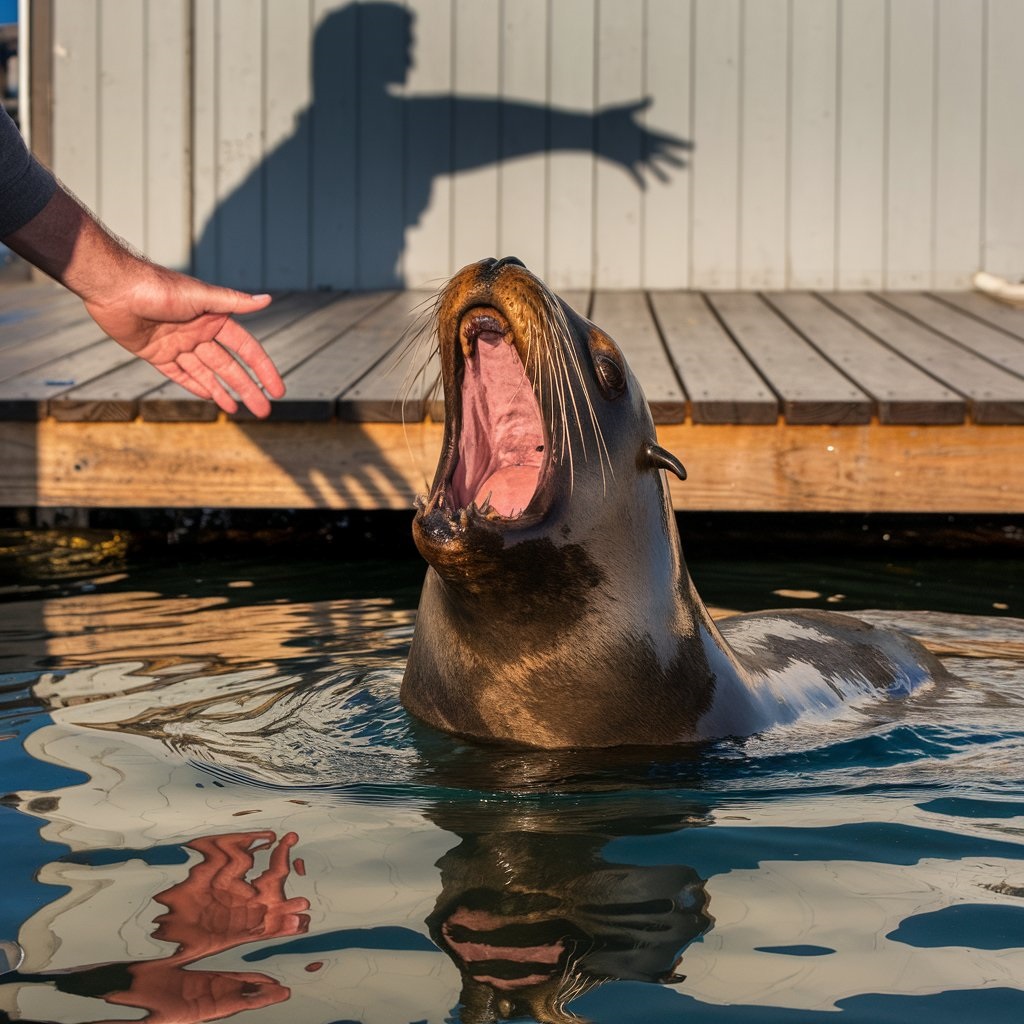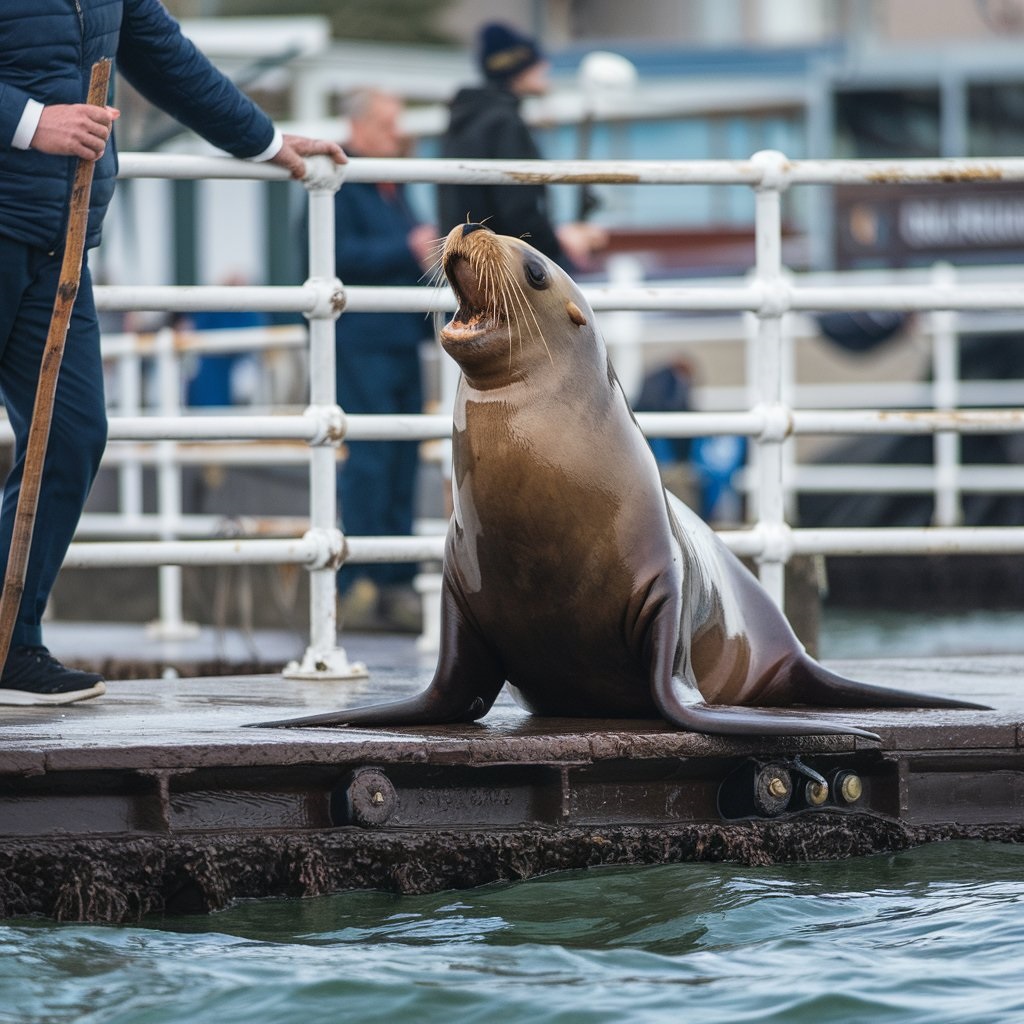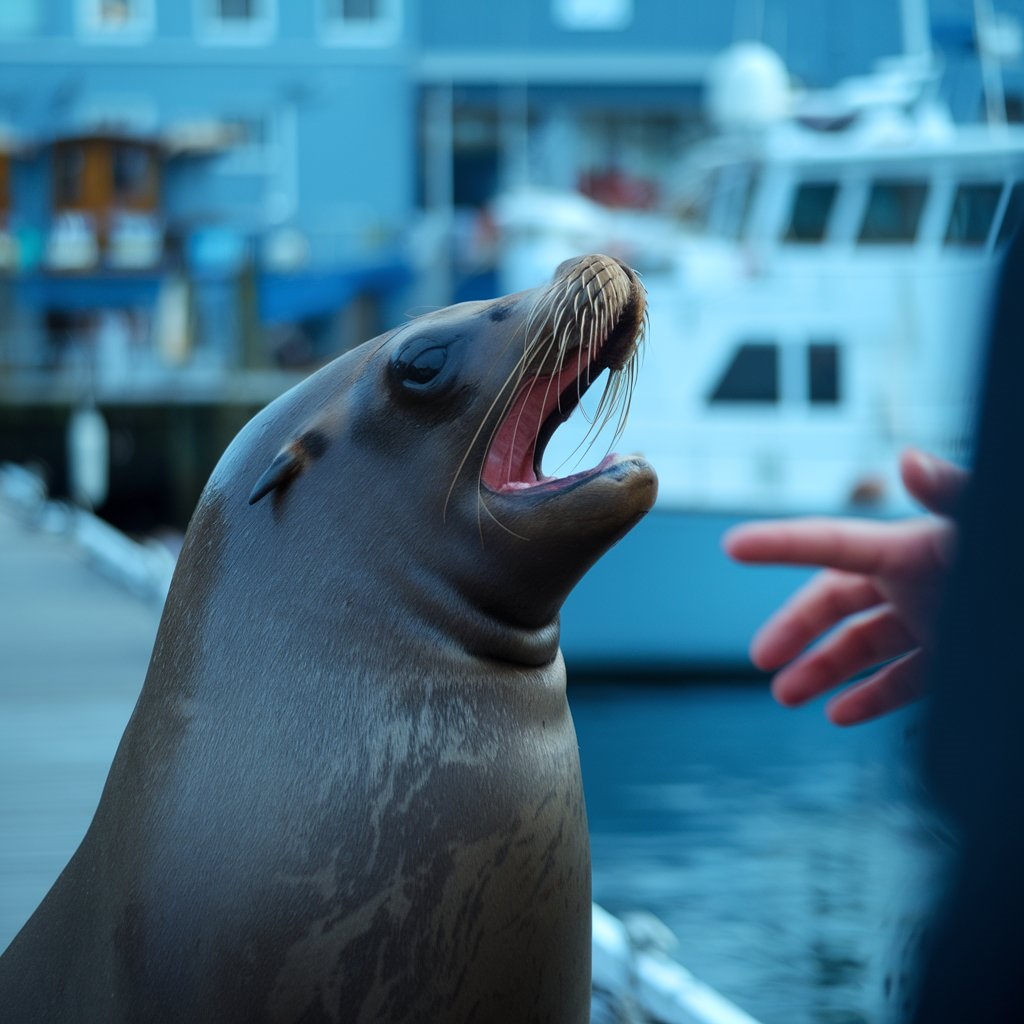When most people think of sea lions, images of playful creatures basking in the sun or swimming gracefully through coastal waters typically come to mind. After all, these charismatic marine mammals are commonly seen in nature documentaries or even in popular tourist spots along the Pacific coast of North America. However, recent incidents have raised questions about whether these creatures could ever pose a threat to humans. Sea lion attacks on humans, while rare, do occur, and the stories are often chilling. So, why do sea lions attack humans?
What drives these normally peaceful creatures to act aggressively? In this article, we’ll dive deep into sea lion behavior, explore the factors that could trigger an attack, and analyze several real-life incidents to understand when and why these animals might lash out. We’ll also provide actionable tips on how to stay safe when encountering sea lions in the wild.
Here’s a table summarizing the key facts and figures from the article:
| Category | Facts & Figures |
|---|---|
| Species of Sea Lions | – California Sea Lion (Zalophus californianus) – Steller Sea Lion (Eumetopias jubatus) – New Zealand Sea Lion (Phocarctos hookeri) |
| Size of California Sea Lion | – Males: Up to 8 feet long, 600-850 lbs – Females: 4-6 feet long, 200-300 lbs |
| Size of Steller Sea Lion | – Males: Up to 11 feet long, 2,500 lbs – Females: 8-9 feet long, 1,000 lbs |
| Key Habitat Locations | – Pacific Coast of North America (California, Alaska, Mexico) – Galápagos Islands – New Zealand Subantarctic Islands |
| Key Prey for Sea Lions | – Fish (herring, mackerel, sardines) – Squid, cephalopods, and octopus |
| Territorial Behavior | – Aggression peaks during breeding season (late spring to early summer) – Males defend territories aggressively |
| Domoic Acid Poisoning Impact | – Affects neurological behavior, causing disorientation, erratic movements, and aggression |
| Safe Viewing Distance | – Maintain at least 50 yards (150 feet) from sea lions, especially during mating season |
| Notable Attack Incidents | – 2017: Girl pulled into water at Steveston Fisherman’s Wharf (Canada) – 2007: Surfer bitten in Western Australia – 2023: Tourist bitten in San Francisco Bay |
| Breeding Season | – Breeding season typically runs from late spring to early summer |
| Safe Interaction Practices | – Avoid feeding or approaching sea lions – Always follow local wildlife safety guidelines |
| Neurological Effects from Algal Blooms | – Harmful algal blooms (domoic acid) have been linked to more aggressive behavior in sea lions |
| Vocalizations | – Sea lions communicate using barks, growls, and roars |
| Aggression Triggers | – Territorial defense, protecting pups, perceived threats, stress, illness, human provocation |
Who Are Sea Lions?
Before jumping into the specifics of sea lion attacks, it’s important to first understand who these animals are. Sea lions are members of the pinniped family, which includes seals and walruses. These mammals are incredibly adaptive, living in coastal regions and thriving in both cold and warm waters. While they are generally perceived as playful and harmless, they are wild animals with complex behaviors that can sometimes lead to unexpected aggression.

Characteristics of Sea Lions
- Physical Features: Sea lions are large marine mammals known for their external ear flaps, long front flippers, and robust, muscular bodies. Adult males can weigh up to 850 pounds and measure as long as 8 feet. Females are smaller and more streamlined.
- Behavioral Traits: Sea lions are social animals, living in groups or colonies. They are highly intelligent, vocal animals and can communicate with each other through barks, growls, and roars. Their agility in the water is exceptional, and they are skilled swimmers, diving to great depths to catch squid, herring, and mackerel.
- Habitats: Sea lions are found along the coastlines of the Pacific Ocean, particularly in regions like San Francisco Bay, Western Australia, and the Galápagos Islands. These animals typically breed on rocky islands or secluded beaches. However, their range extends to many coastal areas across the world, including the subantarctic islands of New Zealand.
Social Structure and Behavior
Sea lions are extremely social creatures. They often live in colonies where they engage in communal activities such as resting, grooming, and vocalizing. Male sea lions, particularly during breeding season, become highly territorial. They defend their breeding grounds aggressively, often engaging in fierce battles with rival males to maintain control over their harem of females. This territorial behavior is one of the leading causes of aggression toward humans.
Why Do Sea Lions Attack Humans?
While sea lions are not typically aggressive toward humans, certain conditions can trigger violent behavior. Understanding these factors is key to preventing such incidents.
Territorial Behavior
One of the primary reasons sea lions may attack humans is territorial behavior. During mating season, particularly from late spring to early summer, male sea lions become highly protective of their territory. The presence of humans near their colony or near a specific sea lion’s territory can be perceived as a threat, prompting aggressive responses.
- Dominance and Defense: Male sea lions defend their territories from intruders, including other males and even humans. These territorial displays may include loud vocalizations, aggressive charging, and physical altercations.
- Incident Example: In 2017, a California sea lion at Steveston Fisherman’s Wharf in Canada attacked a young girl who was leaning over the dock to get a better view. The sea lion, likely feeling threatened by her proximity to its territory, lunged and pulled the girl into the water. While the girl was rescued quickly, the incident serves as a reminder of the dangers of approaching sea lions too closely, particularly during mating season.

Perceived Threats
Sea lions, like many animals, can become defensive when they feel their young are in danger. Mother sea lions are especially protective of their pups, and any perceived threat—whether from a human or another animal—can lead to aggression.
- Protecting Offspring: A sea lion might attack if it feels that its pup is being threatened. This behavior can be more common around breeding colonies, where a large number of sea lions are concentrated in a small area.
- Stress or Illness: When sea lions are stressed or in poor health, they may also act aggressively. The presence of large crowds or loud noises near their habitat may make them more likely to react defensively.
Health Issues: Domoic Acid Poisoning
An increasing concern among marine mammals, including sea lions, is domoic acid poisoning caused by harmful algal blooms. These blooms produce toxins that, when consumed by sea lions, can cause neurological symptoms. Domoic acid poisoning affects the brain, leading to disorientation, memory loss, and in some cases, aggressive behavior. This condition has become more common due to rising ocean temperatures and changes in the marine ecosystem.
- Neurological Symptoms: Sea lions suffering from domoic acid poisoning may display erratic, aggressive behavior. This condition has been linked to several unusual attacks on humans in recent years. Researchers and wildlife experts have noted that animals exhibiting symptoms of poisoning may act unpredictably, posing a risk to humans who are in close proximity.
Human Provocation
Most sea lion attacks happen when humans provoke the animals. This can occur when people try to interact with sea lions by feeding them or getting too close to their territory. Sea lions are wild animals, and like all wildlife, they can be unpredictable if they feel threatened or stressed.
- Feeding Wildlife: When people feed sea lions, the animals may begin to associate humans with food. This behavior can lead to aggressive encounters, especially if the animal becomes possessive over the food source or feels threatened when approached by a human.
- Tourist Interactions: Many incidents have occurred when tourists attempt to touch or take photos with sea lions, ignoring safety warnings. In San Diego, a man was bitten by a sea lion after attempting to take a selfie with the animal. The sea lion, feeling cornered or stressed, responded by attacking.
Notable Incidents of Sea Lion Attacks
Though sea lion attacks on humans are rare, there have been several high-profile incidents that have raised concerns about their aggressive behavior. Let’s examine some of the most notable attacks to understand the context and causes behind these encounters.
Case Study 1: The Girl at the Pier (2017)
In 2017, a California sea lion grabbed a young girl at Steveston Fisherman’s Wharf in Canada. The girl had been standing at the dock, leaning over to get a better view of the sea lion. The animal, possibly feeling threatened by her proximity to its territory, lunged out of the water and grabbed the girl by the dress, attempting to pull her in. Fortunately, the girl was pulled to safety by her family and bystanders. While the attack did not result in serious injuries, it highlighted the risks of approaching sea lions too closely.
Case Study 2: Surfer in Western Australia (2007)
In 2007, a surfer was bitten by a Steller sea lion off the coast of Western Australia. The incident occurred in an area known to be frequented by sea lions. Experts speculate that the sea lion may have mistaken the surfer for a threat or prey, especially since surfers often move in ways that resemble the actions of seals or prey species. The surfer received only minor injuries, but the attack served as a cautionary tale for anyone entering the water near sea lion colonies.
Case Study 3: Recent Incident (2023)
In 2023, a New Zealand sea lion attacked a tourist who attempted to take a selfie with it at a beach near San Francisco Bay. The sea lion, likely feeling threatened by the human’s actions, lunged and bit the tourist. The attack resulted in significant injuries to the arm. This incident underscores the dangers of trying to interact closely with wild animals, even if they appear calm and non-threatening.

Other Recorded Incidents
Beyond the three prominent cases outlined above, there have been many other sea lion attacks in the past few decades. These incidents usually occur when humans approach sea lions too closely, feed them, or disrupt their natural behavior. Researchers have noted that interactions between tourists and sea lions have increased, contributing to more frequent conflicts.
- California Coast: Attacks in areas like San Francisco Bay and Santa Barbara have increased as more people seek close encounters with sea lions.
- Western Australia: In regions such as Ningaloo Reef, there have been incidents of sea lions displaying aggression toward snorkelers and divers who inadvertently get too close.
How to Prevent Sea Lion Attacks
To prevent sea lion attacks, it’s essential to follow some key safety guidelines. By respecting their natural behavior and giving sea lions plenty of space, you can greatly reduce the risk of an encounter turning violent.
Respect Wildlife Boundaries
- Maintain a Safe Distance: Always stay at least 50 yards away from sea lions, especially when they are resting or near their pups.
- Observe from a Distance: Use binoculars or zoom lenses to observe these magnificent creatures without getting too close.
Avoid Provoking Sea Lions
- Never Feed Sea Lions: Feeding sea lions encourages them to associate humans with food, which can lead to aggressive behavior.
- Do Not Approach or Touch: Avoid getting close to sea lions or attempting to touch them. Always respect their space.
Awareness of Sea Lion Behavior
- Watch for Warning Signs: Sea lions may growl, bark, or charge if they feel threatened. If you see these signs, it’s time to back off.
- Avoid Sudden Movements or Loud Noises: Sudden movements or loud noises can startle sea lions and provoke a defensive response.
Educating the Public
- Wildlife Viewing Guidelines: Follow all local guidelines for viewing sea lions. Many areas have posted rules about keeping a safe distance and not feeding the animals.
- Wildlife Tours: Participate in guided wildlife tours where experts can teach you how to safely observe marine mammals.

FAQs
1. Are sea lions aggressive towards humans?
Sea lions are generally not aggressive toward humans but are protected by law, requiring us to observe them from a distance to avoid causing them stress.
2. Is it safe to swim around sea lions?
Swimming near sea lions is not recommended, as they can be unpredictable and potentially aggressive in the water.
3. What do you do if a sea lion approaches you?
If a sea lion approaches aggressively, it’s advised to play dead and protect your face to minimize injury.
4. Do seals attack people in the water?
Seals are typically peaceful but may become aggressive if threatened, especially if they feel trapped or cornered.
5. What happens if a sea lion bites you?
A sea lion bite can lead to infections due to bacteria in their mouths, requiring prompt medical attention.
6. Are sea lions safe to touch?
It is illegal to touch or interact with sea lions due to protections under the Marine Mammal Protection Act.
7. Do sea lions carry rabies?
While rare, sea lions can carry diseases such as Giardia and, in exceptional cases, rabies or tuberculosis.
Conclusion: Living Safely with Sea Lions
In conclusion, while sea lion attacks are rare, they do occur and can be quite serious. Understanding the factors that drive sea lions to act aggressively—whether territorial behavior, perceived threats, or health issues like domoic acid poisoning—is key to avoiding dangerous encounters. By maintaining a safe distance, respecting wildlife boundaries, and following safety protocols, you can enjoy observing sea lions in their natural habitats without putting yourself at risk. These magnificent animals deserve our respect, and by following safe wildlife viewing practices, we can ensure that humans and sea lions can coexist safely.
Read more knowledgeable blogs on Flowy Magazine

James Clair is a passionate writer and researcher with a deep fascination for animal behavior and its intricate connection to human life. With a background in [relevant field of study, e.g., zoology, psychology, ethology], James has spent years studying the natural world, focusing on how animals’ actions and instincts impact human emotions, behavior, and society.
His expertise in [specific topics or regions of focus, e.g., canine psychology, animal communication, wildlife conservation] has led to numerous published works and collaborations with renowned researchers and institutions. Through his work at Flawy Magazine, James aims to bridge the gap between scientific research and public understanding, offering insightful, accessible articles that explore the complex relationship between humans and animals.
When he’s not writing, James enjoys [personal hobbies or interests, e.g., hiking in nature, volunteering at animal shelters, photography] and is an advocate for [cause or charity related to animals or conservation]. His mission is to inspire readers to see animals not just as companions or creatures of the wild, but as beings whose behavior holds valuable lessons for us all.









